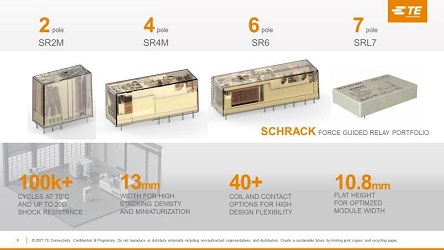Criteria when selecting a relay for use in industrial applications include operating voltage and current, the amount of space available (with special consideration for component separation) and most importantly applicable safety standards. This article will consider how peak inrush current peaks can cause irreparable damage relay contacts which can create safety concerns in equipment such as elevators, industrial cutting machines, and railway signalling. It will also discuss space-constrained environments (like industrial control cabinets) and ways in which the required number of relays can be accommodated.
Relays Selection for Challenging Environments
Industrial systems require an efficient way to control high power rails using low voltages. Electromagnetic relays provide an effective way to do this and can be used to switch multiple contacts using one signal. While relays offer a low-cost solution, in some circumstances, stringent functional safety requirements must be adhered to. For example, a hydraulic press should only begin to function when switched on by an operator operates. Functional safety standards like IEC 61508 (and derivatives applicable to industry), define safety integrity levels (SIL) to protect equipment users and prevent damage to equipment. The IEC 61810-3s safety standard (previously EN 50205), applies to relays used in safety and self-monitoring control applications.
Inrush Currents
Inrush currents have the potential to cause damage to any piece of electrical switchgear like switches, contactors, and relays. These occur when the supply voltage arriving at a load causes the flow of current to be too high. Inductive loads like motors and transformers, and capacitive loads like energy storage cells, are especially liable to high inrush currents which can be up to forty times higher than the steady-state current. In a relay, the sudden surge of current surge can cause instantaneous arcing between its contacts, welding them together. The relay can appear to still operate as expected, but it can no longer be switched off.
Several ways exist to lower inrush currents, including slowly increasing the applied load voltage or using a zero crossover switch (ZCS), like a solid-state relay (SSR). A ZCS works on an AC supply voltage by detecting when the voltage becomes zero, and hence zero current, at the zero-crossing point between the positive and negative peaks. At this point, the relay can switch the load on or off.
However by their very nature, in inductive loads the point of maximum current lags the peak voltage, thereby offsetting the times when zero voltage and current occur. As a result, the zero crossing and solid-state relay approach can cause high switching high currents. Another issue is that ZCS/SSRs are a source of unwanted electromagnetic interference (EMI) making complying with functional safety using a ZCS/SSR complicated.
Force Guided Relays
The easiest way to reliably and safely perform switching circuits is to use a force guided relay (FGR), which are covered by the IEC 61810-3 standard. These are constructed method so that normally-open (make/NO) contacts cannot be in the same state as normally-closed (break/NC). If contact welding or other types of failure happen within the relay, the forced movement of contacts ensures that a minimum distance of 0.5 mm exists between the failed contacts.
TE Connectivity’s SCHRACK portfolio of force-guided relays is commonly used in safety-related applications, including safety interlocks, emergency stops, and robot control systems. Other than industrial applications, FGRs are used in places like elevator door controls, railway signaling, and medical diagnostic equipment.
The SCHRACK portfolio has several design options including multiple contact configurations, contact plating options, and a variety of pin configurations for higher voltage ratings. Standard and sensitive coil options offer longer product lifetime and better heat dissipation.
The SCHRACK SR2M FGR is a 2-pole relay and has reinforced insulation between its poles and complies with EN61810-3. Its switching contacts are rated for 250 VAC (400 VAC maximum) and a rated switching current of 6A. The contact material is made from silver nickel (AgNi). The contact is arranged in 1 Form A (SPST-NO) and 1 Form B (SPST-NC). The relay coil operating voltage is model-dependent and supports nominal voltages from 5 VDC to 110 VDC. The relay is available in either a soldered or plug-in pin format.
Common applications for the SR2M include hydraulic press control, emergency shut-off, elevator and escalator control, and safety monitoring.
The four-pole SCHRACK SR4D/M relay is available with either 3 form A and 1 form B contacts 3 NO + 1 NC or 2 form A + 2 form B contacts 2 NO + 2 NC. The contact material is made from a silver tin oxide (AgSnO2), and it has a rated current per contact is 8 A.
FGRs for Space-Constrained Industrial Applications
DIN-rail mounted process logic controllers (PLCs) located in a control cabinet are used to control most industrial production assets. More and increasingly compels equipment and machinery puts pressure on the amount of available factory floor space meaning engineers are limited to a single control cabinet per production asset. Modern industrial controllers have high power density of features, which means they dissipate more heat in smaller areas.
The SCHRACK XT is available in single pole or two-pole variants with rated currents of 16 A (1P) or 8 A (2P). It can be ordered with either a 24 VDC coil or a 24 VAC, 115 VAC, or 230 VAC coil.
Keeping Industrial Electrical Systems Operating Safely
Total compliance with safety standards is required in order to guarantee the safety of people and is especially relevant in industrial processes where high voltage machinery and process equipment are present. Functional safety standards define the framework for assessing and determining risks, and in the case of relays, the IEC 61810-3 specification required force guided relays to be used in safety control applications. TE Connectivity’s SCHRACK portfolio of FGRs are essential for any safety-related applications.
TE Connectivity, TE connectivity (logo), TE, and SCHRACK are trademarks owned or licensed by the TE Connectivity Ltd. family of companies. Other products, logos and company names mentioned herein may be trademarks of their respective owners.








